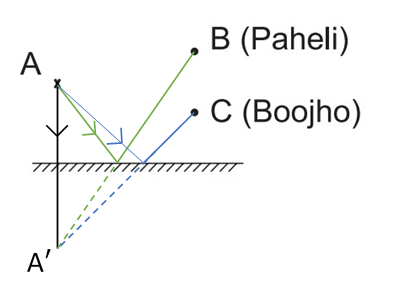NCERT Solutions for Class 8 Science Chapter 13 Light and Flame help students to clear all their doubts. These solutions provide you with the answers to all the questions given in the NCERT textbook. CBSE Class 8 Science Chapter 13 Solutions is prepared by expert teachers as per the latest CBSE syllabus and guidelines.
Solving NCERT Solutions will help you to understand the concepts related to Light NCERT Solutions for Class 8 Science Chapter 13 contains an in-depth explanation of each question of NCERT Science textbook. These solutions cover important concepts in different patterns like MCQs and short answer questions, worksheets and more and help you top score good marks in the exam.
Class 8 Science Light Questions and Answers
Exercise Questions
Question 1: Suppose you are in a dark room. Can you see objects in the room? Can you see objects outside the room? Explain.
Answer: We can see any object, when light reflected by that object reaches to our eyes. But in the dark room, no light is reflected by the object. Hence, we are not able to see the objects in dark room. But if there is light outside the room, we can see the objects lying out there.
Question 2: Differentiate between regular and diffused reflection. Does diffused reflection mean the failure of the laws of reflection?
Answer:
| SL.No. | Regular Reflection | Diffused Reflection |
| 1. | It takes place from a smooth place. | It takes place from a rough surface. |
| 2. | Reflected rays moves in a particular direction. | Reflected rays scattered in random directions. |
| 3. | Example: Reflection by plane mirror. | Reflection by road surface. |
Question 3: Mention against each of the following whether regular or diffused reflection will take place when a beam of light strikes. Justify your answer in each case.
(a) Polished wooden table
(b) Chalk powder
(c) Cardboard surface
(d) Marble floor with water spread over it
(e) Mirror
(f) Piece of paper
Answer 3: (a) A polished wooden table is an example of smooth surface. So, when a beam of light reflects from it, a regular reflection will take place.
(b) Chalk powder has irregular surface. So, when a beam of light reflects from it, a diffused reflection will take place.
(c) A cardboard has irregular surface. So, when a beam of light reflects from it, a diffused reflection will take place.
(d) A marble floor with water spread over it provides a smooth surface. So, when a beam of light reflects from it, a regular reflection will take place.
(e) A mirror has a smooth surface. So, when a beam of light reflects from it, a regular reflection will take place.
(f) A piece of paper may appear smooth but it has many minor irregularities. So, when a beam of light reflects from it, a diffused reflection will take place.
Question 4: State the laws of reflection.
Answer 4: Laws of reflection states that:
- The angle of incidence is always equal to the angle of reflection.
- The incident ray, the reflected ray and the normal to the surface at the point of incidence lie in the same plane.
Question 5: Describe an activity to show that the incident ray, the reflected ray and the normal at the point of incidence lie in the same plane.
Answer 5: Fix a white sheet of stiff paper on a drawing board or a table. Take a comb and close all its openings except one in the middle. Hold the comb perpendicular to the sheet of paper. Throw light from a torch through the opening of the comb from one side. With slight adjustment of the torch and the comb we will see a ray of light along the paper on the other side of the comb. Keep the comb and the torch steady. Place a strip of plane mirror in the path of the light ray.
Let the sheet project a little beyond the edge of the Table. Cut the projecting portion of the sheet in the middle. Look at the reflected ray. Make sure that the reflected ray extends to the projected portion of the paper. Bend that part of the projected portion on which the reflected ray falls. Bring the paper back to the original position.
When the whole sheet of paper is spread on the table, it represents one plane. The incident ray, the normal at the point of incidence and the reflected ray are all in this plane. When we bend the paper you create a plane different from the plane in which the incident ray and the normal lie. Then we do not see the reflected ray. It indicates that the incident ray, the normal at the point of incidence and the reflected ray all lie in the same plane.
Question 6: Fill in the blanks in the following:
(a) A person 1 m in front of a plane mirror seems to be _______________ m from his image.
(b) If you touch your ____________ ear with right hand in front of a plane mirror it will be seen in the mirror that your right ear is touched with ____________.
(c) The size of the pupil becomes ____________ when you see in dim light.
(d) Night birds have ____________ cones than rods in their eyes.
Answer 6: (a) A person 1 m in front of a plane mirror seems to be 2m away from his image.
(b) If you touch your left ear with right hand in front of a plane mirror it will be seen in the mirror that your right ear is touched with left hand.
(c) The size of the pupil becomes large when you see in dim light.
(d) Night birds have less cones than rods in their eyes.
Question 7: Choose the correct option: Angle of incidence is equal to the angle of reflection
(a) Always
(b) Sometimes
(c) Under special conditions
(d) Never
Answer 7: (a) Always
Question 8: Choose the correct option: Image formed by a plane mirror is
(a) virtual, behind the mirror and enlarged.
(b) virtual, behind the mirror and of the same size as the object.
(c) real at the surface of the mirror and enlarged.
(d) real, behind the mirror and of the same size as the object.
Answer: (b) virtual, behind the mirror and of the same size as the object
Question 9: Describe the construction of a kaleidoscope.
Answer: A kaleidoscope is made up of three rectangular mirror strips joined together to form a prism. These are fix in a circular cardboard-like tube or tube of a thick chart paper. The tube is slightly longer than the mirror strips. One end of the tube remains closed by a cardboard disc having a hole in the centre, through which one can see. To make the disc durable, a piece of transparent plastic sheet is pasted under the cardboard disc. At the other end, touching the mirrors, a circular plane glass plate is fixed. On this glass plate, several small pieces of coloured glass are placed to form multiple images.
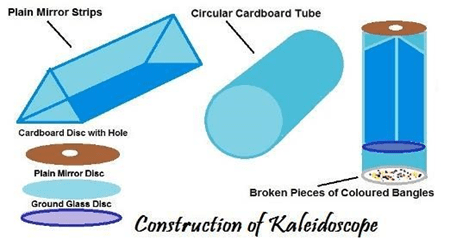
Question 10: Draw a labelled sketch of the human eye.
Answer:
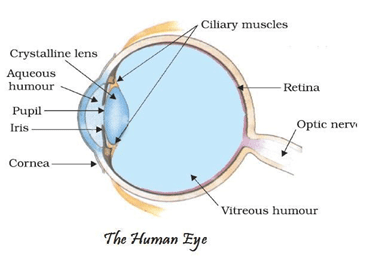
Question 11: Gurmit wanted to perform Activity 16.8 using a laser torch. Her teacher advised her not to do so. Can you explain the basis of the teacher’s advice?
Answer: Intensity of laser beam is very high, as it carries large amount of energy. It is harmful for eyes and can cause permanent damage. One should not look at laser beam directly or indirectly for a longer period.
Question 12: Explain how you can take care of your eyes.
Answer: The following points help a person to take care of his eyes:
(a) It is necessary that we take proper care of our eyes. If there is any problem we should go to an eye specialist. Have a regular check-up.
(b) If advised, we should use suitable spectacles.
(c) Too little or too much light is bad for eyes. Insufficient light causes eyestrain and headaches. Too much light, like that of the sun, a powerful lamp or a laser torch can injure the retina.
(d) We should not look at the sun or a powerful light directly.
(f) Never rub our eyes. If particles of dust go into our eyes, wash our eyes with clean water. If there is no improvement go to a doctor.
(g) Wash our eyes frequently with clean water.
(h) Always read at the normal distance for vision. Do not read by bringing your book too close to our eyes or keeping it too far.
Question 13: What is the angle of incidence of a ray if the reflected ray is at an angle of 90° to the incident ray?
Answer: We know that angle of incident ray is equal to angle of reflected ray.
i.e., ∠𝑖 = ∠𝑟
But it is given that
∠𝑖 + ∠𝑟 = 90°
⇒ ∠𝑖 + ∠𝑖 = 90°
⇒ 2∠𝑖 = 90°
⇒ ∠𝑖 = 90°/2
⇒ ∠𝑖 = 90°
Question 14: How many images of a candle will be formed if it is placed between two parallel plane mirrors separated by 40 cm?
Answer: Infinite number of images.
Question 15: Two mirrors meet at right angles. A ray of light is incident on one at an angle of 30° as shown in Fig. 16.19. Draw the reflected ray from the second mirror.
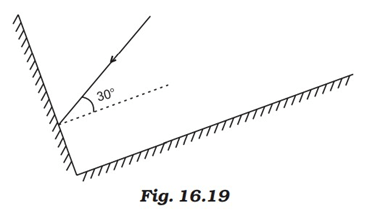
Answer: The first law of reflection is used to obtain the path of reflected light.
It can be observed that the given ray of light will reflect from the second mirror at an angle 60°.
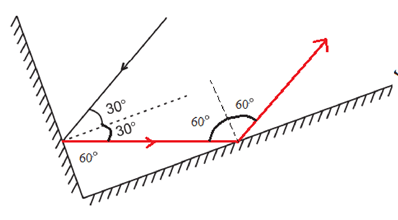
Question 16: Boojho stands at A just on the side of a plane mirror as shown in Fig. 16.20. Can he see himself in the mirror? Also can he see the image of objects situated at P, Q and R?
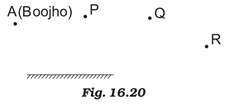
Answer: Boojho can’t see his own image because he is not standing in front of the mirror. However, he is able to see objects at P and Q because the rays coming from P and Q get reflected by mirror and reach to his eyes. The ray from object R does not reflect and reaches Boojho, so, he cannot see object R.
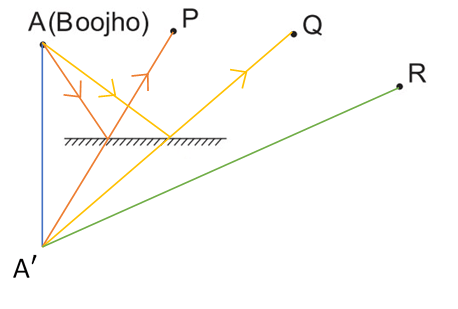
Question 17: Find out the position of the image of an object situated at A in the plane mirror (Fig. 16.21).
(a) Can Paheli at B see this image?
(b) Can Boojho at C see this image?
(c) When Paheli moves from B to C, where does the image of A move?
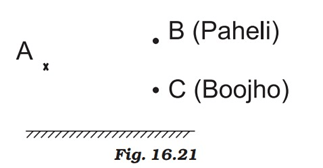
Answer: (a) The image of the object at position A will be formed behind the mirror. It will be at the same distance away from the mirror as the object is.
(b) Yes. Paheli at B can see the object because reflected ray from A will reach B.
(c) Boojho can also see the image because his eyes receive the reflected ray from A.
(d) If we trace the reflected rays from B and C backwards, they converge at point behind the mirror. Position of image A remains fixed even if Paheli moves from B to C.
